
Double checked the banquet we were holding for Dr. Liu and his staff in the evening with the Hotel kitchen. It's on.
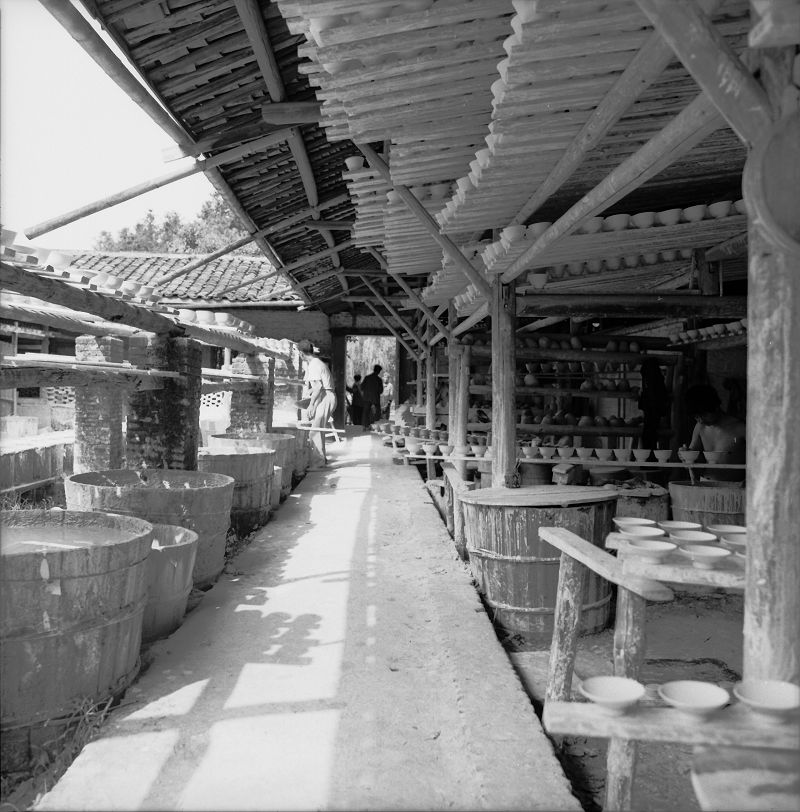
In the Ancient Porcelain Factory and Museum Area are a number of reconstructed porcelain pavilions. In one wing clays and glazes are prepared, in the other you can follow every step in ancient porcelain production can be followed from throwing to decoration. In the middle of the courtyard is a variety of wooden vessels where porcelain clay and glazes are kept in their various stages of preparation.
Photo by Jan-Erik Nilsson, Jingdezhen, 17 September 1992.
Powwow at the hotel room about what to do with the Ancient Porcelain Factory or the 'Ancient Porcelain Historical Relics Regions of Jingdezhen' as the brochure has it. Jarl considered - with some right - the whole thing a worthless tourist theme park.
Comparing what I know of ancient porcelain making from the literature, I think the pottery part on the whole is simplified but very real. The traditional way of making porcelain is something that has been developed over a period of some one thousand years and is nothing that you can change much. You put in clay in one end and you expect underglaze blue and white porcelain to come out on the other end. Whatever need to be in-between is probably exactly what has always been there or it won't work.
Someday the ceramics industry in Jingdezhen will be all modernized, they are setting up an imported German kiln somewhere as we speak, but we are certainly not there yet. As soon as you get outside of the largest state owned "Ten Factories" you can see these methods or versions of it at any number of places in and around Jingdezhen. It's just the pavilions and some aspects of the logistics that are older than what is still in everyday use around here.
I talk Jarl into going there anyway. At the entrance they however want to charge us like 3 Yuan in entrance fee why Jarl now feel that is a complete rip off and is just about prepared to turn around an go back to the hotel. I point out that we have spent about two weeks and I don't know how much efforts to get here, and that I'd rather cover his 3 Yuan than just go back home again, besides, the cab was more ...
We go in and visit again the entire area. Houses, parks, exhibitions and all and I add new photos to my stock of the traditional porcelain manufacturing processes. The entire ceramic production line is in full swing but besides the workers and us, there are nobody here.
Set up in 1979, the Ancient Ceramic Tourist Area is situated in Panlongang of the Fengshushan Hills in the western part of Jingdezhen. The area was opened to the public in 1984. When I saw this the first time it was pretty new and had been up for six years only. Now it has been up for eight. Not much have changed.
The area this is set up on is rather large. It covers 830,000 square meters and is organized in a number of themes in which ancient porcelain making is only one. By now I have been here several times and I feel I figure out some new details in ancient porcelain making every time I go through this place. The remaining is focusing on architecture and landscaping.
The Ancient Porcelain Factory is in the easternmost part of the area. It is a reproduction of a part of the Ming and Qing imperial porcelain factory. It consists of a number of porcelain pavilions and a Jingdezhen kiln (wood kiln).
The ceramic work-shops are arranged in rows with a series of ancient pottery stalls where the different steps in the production chain are demonstrated.
The process begin with clay preparation and continues through shaping of the vessels, to underglaze decoration, glaze application and at the end of the line, firing.
It shows the tools, processes and materials used in traditional porcelain making, up an including firing them with pine wood in a huge egg shaped kiln that was the epitome of Late Ming to Qing dynasty ceramics technology. The tools, processes and materials are the ones recorded in Song Yingxing's Tiangong Kaiwu or The Exploitation of the Works of Nature, published in 1637.
As for authenticity this fits very well with the oldest photographs I have seen from old Jingdezhen and it works. I would not be surprised if they just gutted what was left of the Imperial porcelain factory and set it up here as a museum. They might just as well have kept the staff too.
Jingdezhen didn't see any real modern factories before the end of the 1950s. Before that I think most Chinese porcelain factories might have looked like this. A 1920 article in National Geographic in fact tells that 'there is only one factory in Jingdezhen where you can see all the steps in the manufacturing process in one place'. As far as I can tell that must have been the former Imperial kiln, or as it was called at that time, the Jiangxi Porcelain Company.
This is the clay storage area facing north. In the middle of the picture is seen a number of large vats. These are used to dissolve the clay lumps and bricks to a homogeneous slur that could be mixed and dealt with. In the pavilion to the right are seen three kinds of lumps and bricks. The closest one, that goes a bit into red, I think is kaolin. Everywhere except here you are getting the information that kaolin is white, but as far as I can tell it only becomes white after firing. I don't know this and there is not much point in guessing.
Furthermost in this pavilion are light gray bricks. To my mind, that is powdered China stones, meaning crushed stones that makes up the flesh part of porcelain. The bones, is the un-meltable kaolin china clay. We have seen this being produced all over the place and it looks exactly like that. Then in the middle between these two storages is a gray not very exciting looking mud pile. What this is escapes me but it could be one of two things. Either it is the base ingredients to the glaze or a cheaper ready made clay made to make the wads that the porcelain is actually supposed to rest on while being fired.
If we look carefully under the roof of the pavilion to the right there seems to be an endless supply of flat wads that probably can't be anything except firing supports that will go into the kiln under the pieces being fired so that they will not stick to the saggars. To the extreme left there are smaller vats covered with protective mats. These are as far as I understand the final storage and aging pots for the ready made porcelain clay.
All this reclaimed shavings and ready made porcelain clay is circulated back to, dried and processed into neat lumps that are delivered to the potters working at the wheel.

Clay storage area. The various clays, pastes and ingredients are stored in one side of the factory. The mixing is made in large vats. After that the mixing is done the paste is scooped up and dried by studding the moist paste with dry bricks that helps the water to evaporate until right consistency is arrived at.

After that the paste have been created by mixing China stone with Kaolin in a more or less liquid state, the paste need to be dried out. To this end the paste pile is studded with dry bricks that soaks out the water and help it evaporate. If you just let the mud pile dry up by itself it would develop a crust and you'd be back to soaking and kneading again.

This is the last stage of the porcelain paste preparations. No the porcelain paste is near perfect and just needs to be shaped into big and perfectly soft and malleable porcelain clay lumps and have them delivered to the potter.

The first step in the shaping process is to put a piece of clay onto a potters wheel and create a basic shape.
This entire process takes I would estimate a quarter of a minute. I think that if the potter want, he can get much closer to the finished shape here by spending more time on it. It would probably be at the expense of precision but would work for export minyao porcelain.
As an alternative, the shape could also be created by just pressing a lump of clay on top of an inside mould.
But, this is a replica of the imperial kiln and the process was here probably divided into more steps for increased precision.
The finished rough shape made here is placed on a plank to dry. To the left in the picture, on the potters right side, are three lumps of ready made porcelain clay from the clay house.

Porcelain is not turned into its final shape. Only the basic shape is turned, or pressed onto a mould. After the basic shape have dried to leather hard state, it is put on a lathe and shaved down to its final thickness with a steel knife. In history other materials than steel, such as bamboo or bone, could have been used.
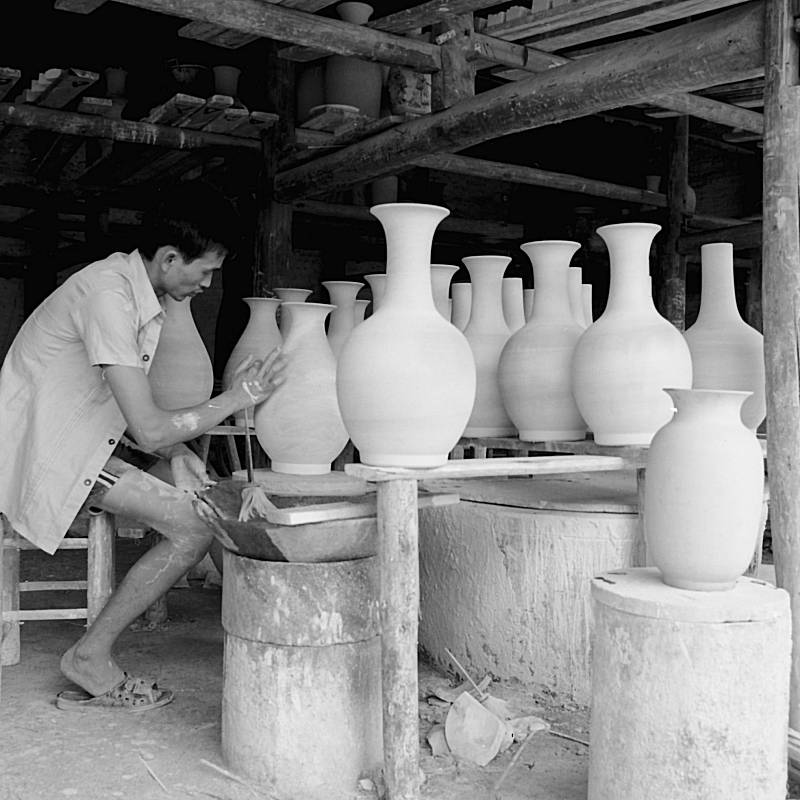
Final polishing before glazing.
Larger objects are made up by several parts and joined by means of some wet clay. Eventually the outside need to be polished to remove all traces of the joint. In old times even smaller objects like jars were press moulded and combined from segments leaving a clearly visibly joint on the inside.
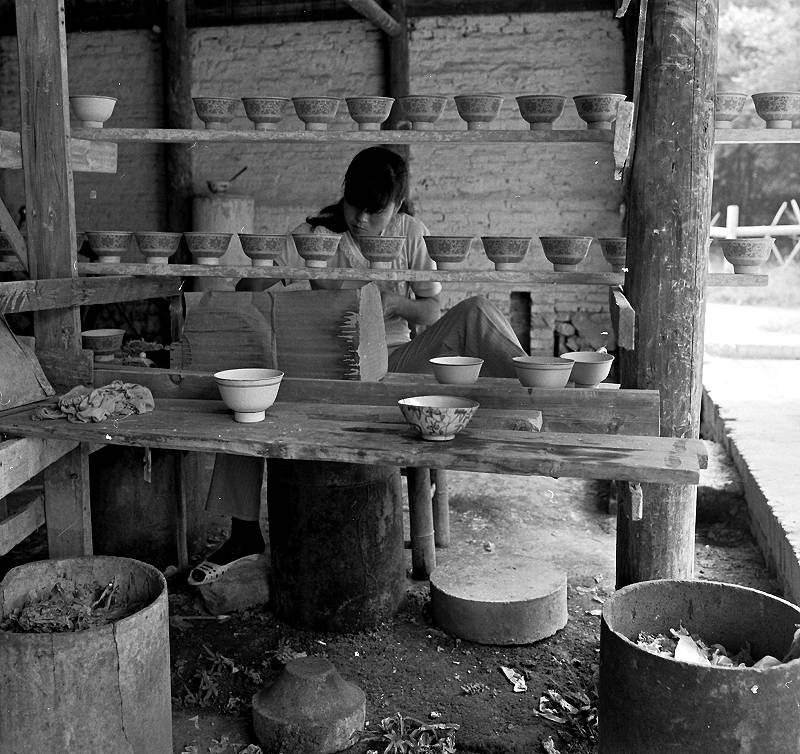
The underglaze blue and white decoration is added directly onto the unfired and unglazed porcelain body. The foot is also still a stub, solid and not scooped out yet. This is not done until after the glaze has been added on the in and outside of the porcelain. The white glaze hides temporarily the decoration so that the mark is added without it being possible to see how the decoration is oriented.

There are several ways of glazing a bowl. Here the bowl is sunk down in a vat of glaze to its rim, left to dry, and after that the inside is glazed by filling it up with some glaze and swirling it around. Here the excess is emptied back into the glaze vat.
.jpg)
Porcelain pavilion, glazing area.
The base and footrim is shaped, marked and glazed as an absolute last finishing moment.

Final shaping of the foot.
The bowl is now decorated in underglaze blue and have had its glaze added onto the outside. The last process is to shave out the foot rim, add a mark and glaze. The bowl is then ready for firing. By comparing the bowls to the left with their foot stub / handle still in place, and the finished bowls to the right, you can see how much porcelain clay is actually removed to finish the foot rim. The standardized precision in this work repeated over the centuries is comparable to that of a Swiss watchmaker. No variations and no deviations are allowed or the entire production chain would break.
After that the mark had been added all that remained was the glazing of the base inside of the foot rim. The full boards are gathered up into a larger frame structure and is then carried away to the furnace for loading in the firing capsules - the saggars - and to be fired.

This is looking down the "shape and glaze" side of the south facing pavilion. Under the roof to the right are decorated bowl in their final stage, with their decoration visible. The large wooden vats here are probably for liquid glaze. After that an unfired porcelain piece is glazed you can no longer see the decoration. Other vats are probably for taking care of porcelain clay shaved off in the process of shaping. Immediately behind me here is the exit towards the kiln.
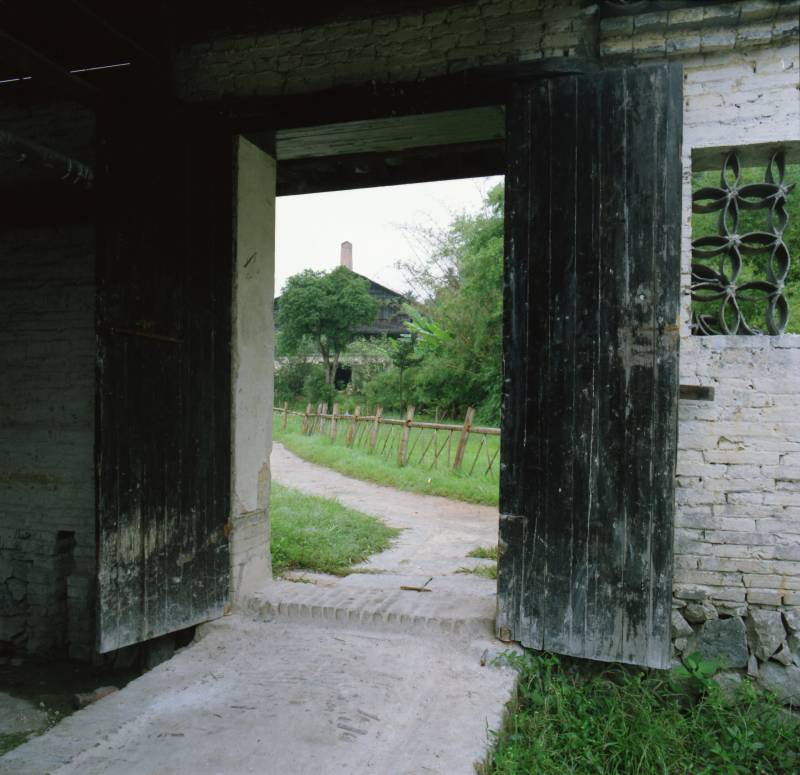
From the pottery pavilions to the kiln is just a short way.
The planks filled with unfired porcelain would be carried from here to the kilns on a large rack carried by standing on the inside of it making it possible to carry several hundred of pieces of porcelain at one time.
On the area is a traditional wood-fired kiln of a kind that was developed in Jingdezhen at the end of the Ming dynasty and in used ever since. Probably as a mean to deal with the large quantities requested by the late Ming emperors and from then on to meet the demands from the export industry. This kiln construction allows for firing a wide variety of good at the same time since the temperatures varies a great deal from front to end in this large kiln.
It is very difficult to find any firm information about anything and you don't really know what aspect of a question the person you ask is answering. From one aspect they say that this kiln is one of Jingdezhen's oldest. If that mean it has been here for "decades" or for centuries is not possible for me to tell, but it has been used and for quite some time. And the model as such goes back to the late Ming dynasty. So if it has been standing here or somewhere else I can't tell. Kilns are also rebuilt on a regular basis or they will collapse by themselves, so who knows.
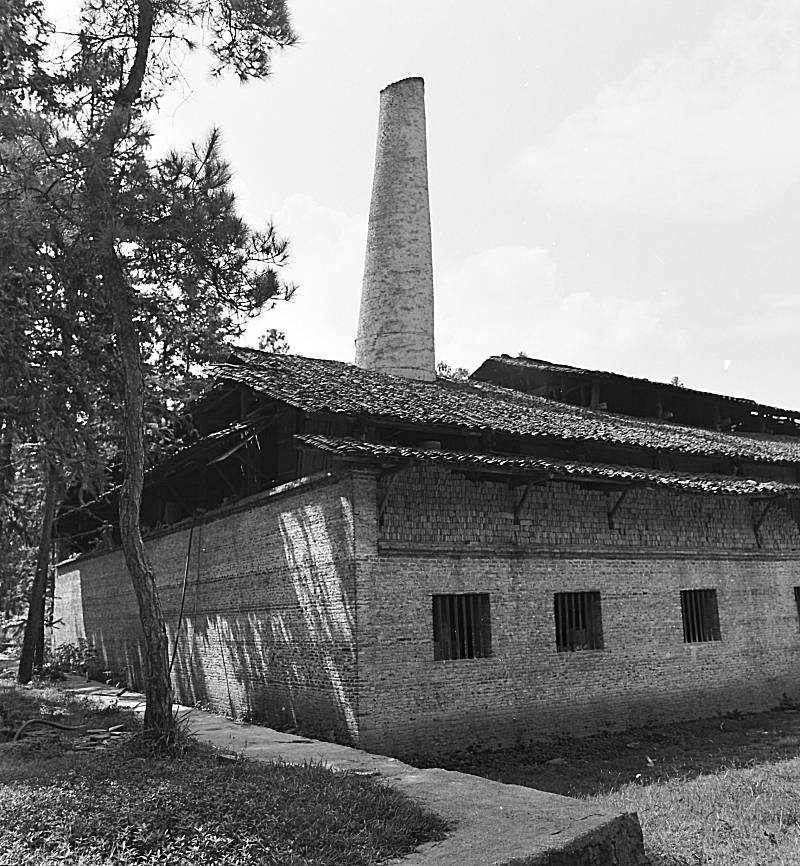
Under a roof in the left part of the building is the actual kiln that occupies about half the building.
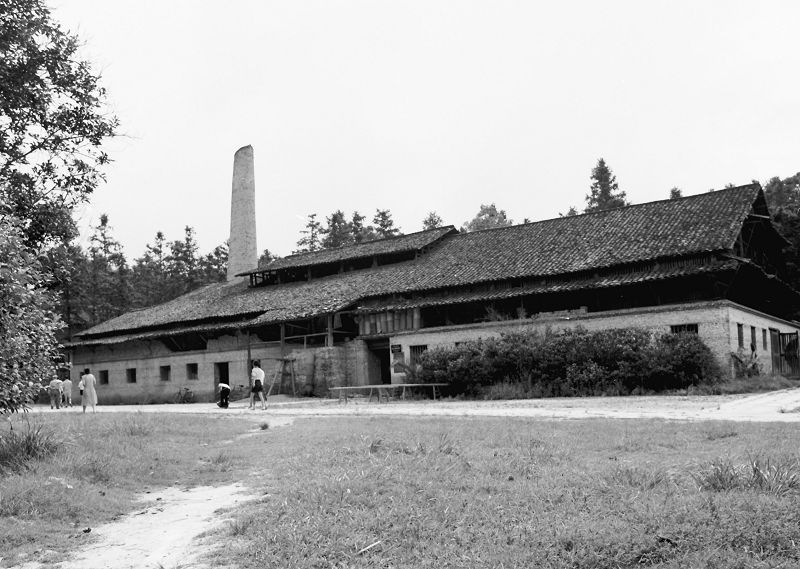
The right half is built with two levels. The lower level is used to store porcelain wares that are to be fired.
The upper floor is used to store firewood that when the furnace is fired will be thrown down through a hatch in the floor.
Photo © Jan-Erik Nilsson, Jingdezhen, 17 September 1992.
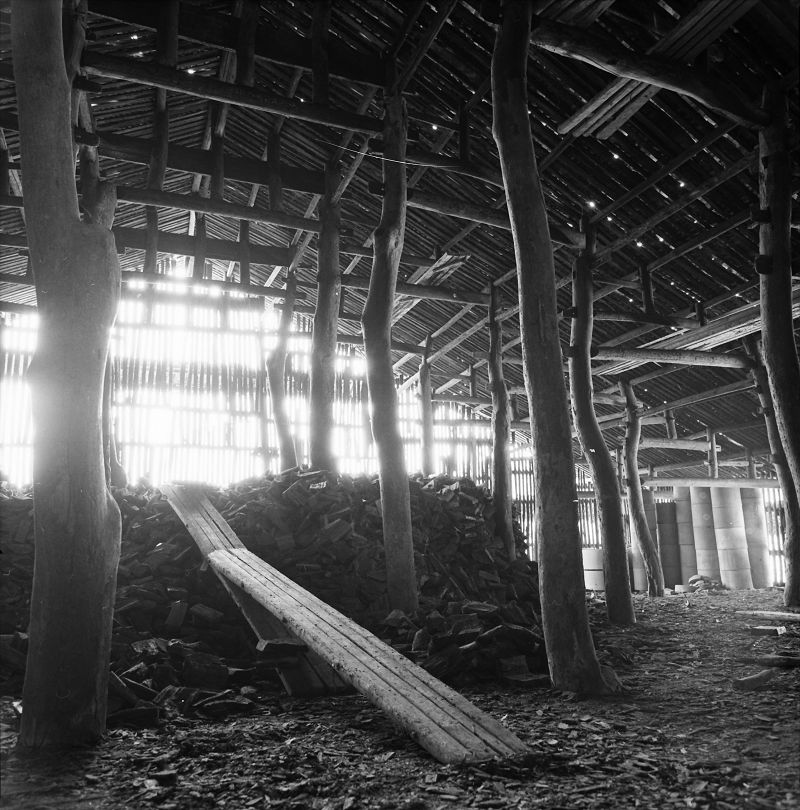
The fire wood loft as seen approximately from the location of the hatch in the floor.
In the rightmost corner are piles of circular firing protection capsules 'saggars', inside which the unfired porcelain would be set.
Photo © Jan-Erik Nilsson, Jingdezhen, 17 September 1992.
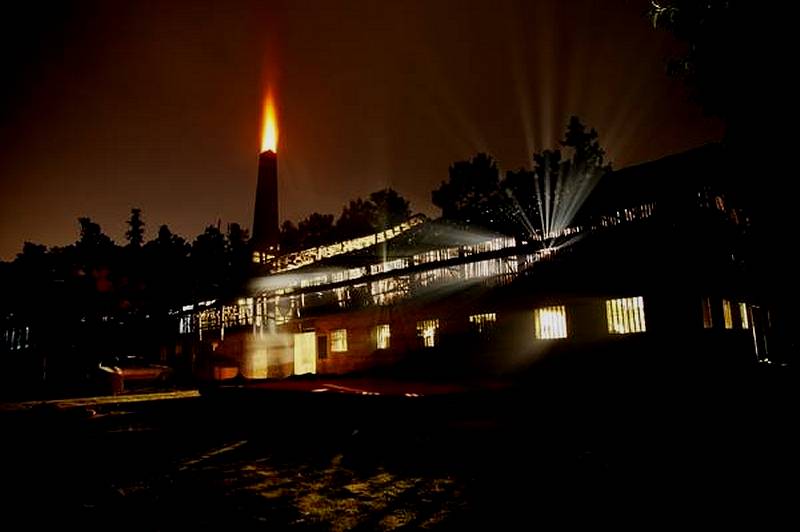
Archive picture from Jingdezhen. Personally I have never seen one of these kilns being fired, but to have several of these lit up at night as is described in the literature must have been a spectacular and ave inspiring sight.
The buildings are original to something, but not to this area. The beams and the wooden parts of the buildings seems to be original and moved here, while the brick work is built up to be identical with the original structures.
In the middle of this area is a porcelain decorator's paintings and calligraphy pavilion that looks very luxurious but could well have been the property of any of the more famous Friends of Zhushan in the early 20th century.

Porcelain decorator's paintings and calligraphy pavilion
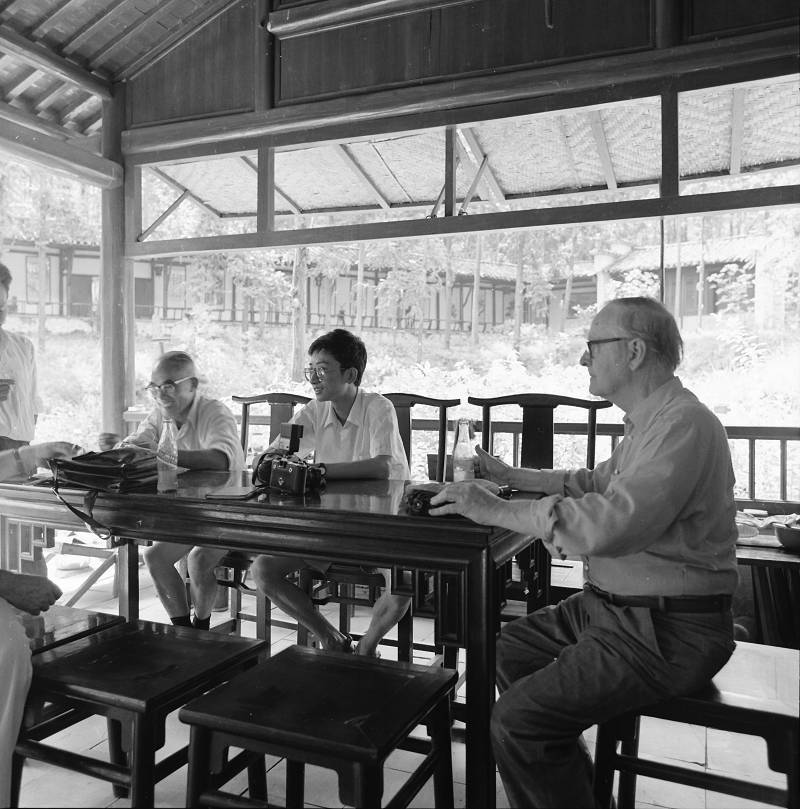
Visiting the porcelain painters pavilion at the Historical Porcelain Exhibition Area
In the western part of this area is the Qing Yuan which is four private residential buildings from the Qing Dynasty. In the center is a Qing memorial temple called Yuhutong, and behind this a Qing dynasty tea merchant house, and a "Jingshi" scholars mansion - a Daifudi.
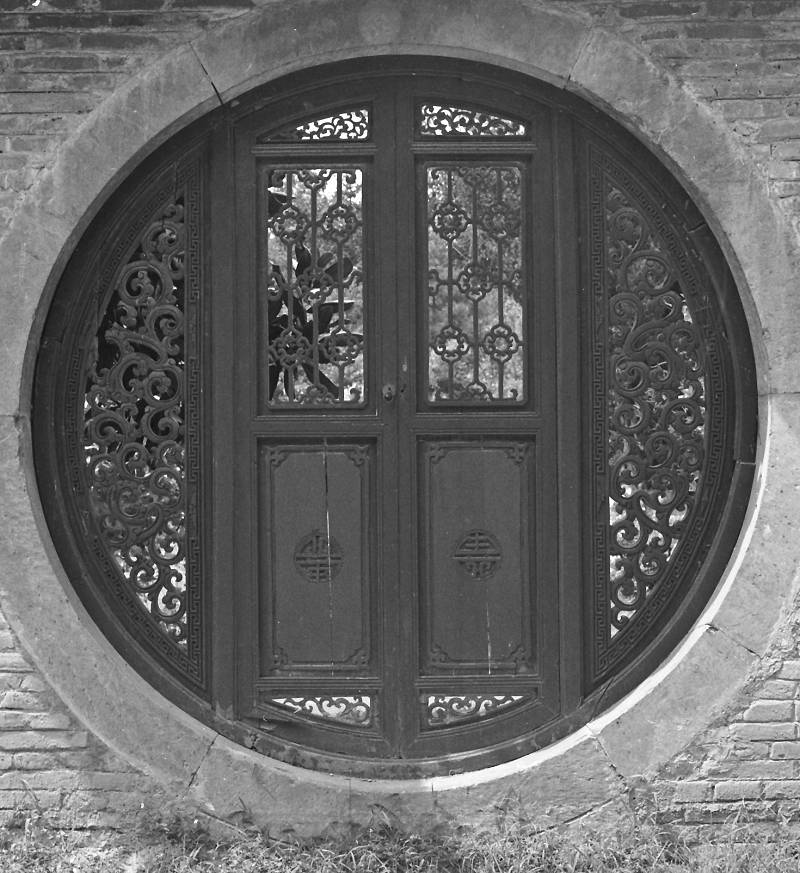
Traditional Chinese garden door
The Yuhuatong temple behind the mansion has been heavily reconstructed and is not much more than a souvenir shop. Beyond that is a small temple though, dedicated to the three deified founders of porcelain making, venerated as the source of Jingdezhen's past wealth - the discoverer of china clay, the inventor of forming techniques, and the inventor of firing - worship of whom is unique to Jingdezhen.
This small altar seems to be real though and about 300 years old, and seems not to have been renovated since, giving it a rather distressed charm. It is a fair chance that this is older that that and in fact the altar that Père d'Entrecolles is talking about being in his letters of 1712 and 1722 that were set up to the God of the Furnace because of an firing accident in the Ming dynasty.
The Daifudi houses an exhibition of paintings related to the progress of decorative arts and the ceramic history.

Ming building at Ancient Kiln site.
Right behind the Qing area is the "Ming Street". These are a group of buildings from in the Ming Dynasty including residences, shops, gates and a memorial temple with big beams that was constructed during the Zhengde and Jiajing periods of the Ming Dynasty, and a Ming Dynasty lakeside garden with pavilions and bridges.
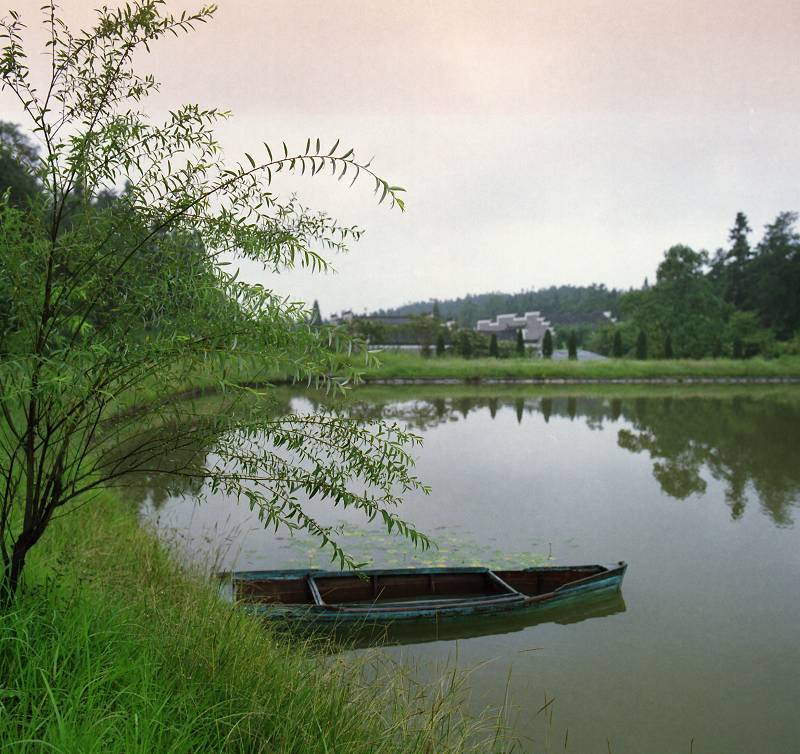
Historical Ming park, village in the distance.